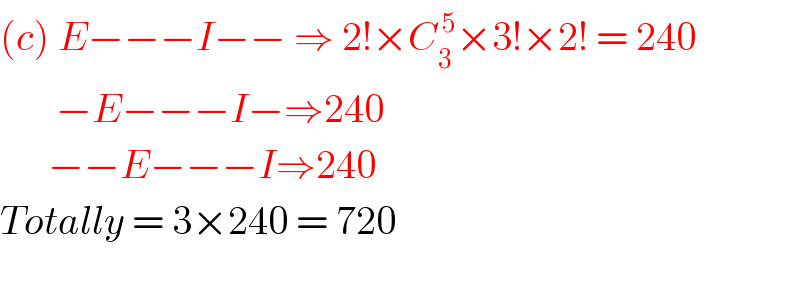
Previous in Permutation and Combination Next in Permutation and Combination
Question Number 119397 by bemath last updated on 24/Oct/20

$${Find}\:{the}\:{number}\:{of}\:{possible}\:{arrangements} \\ $$$${of}\:{the}\:{letters}\:{in}\:{the}\:{word}\:{PENCILS}\:{if} \\ $$$$\left({a}\right)\:'{E}'\:{is}\:{next}\:{to}\:'{I}' \\ $$$$\left({b}\right)\:{E}\:{comes}\:{before}\:{I} \\ $$$$\left({c}\right)\:{there}\:{are}\:{three}\:{letters}\:{between}\:{E}\:{and}\:{I} \\ $$
Commented by liberty last updated on 24/Oct/20

$$\left({c}\right)\:{E}−−−{I}−−\:\Rightarrow\:\mathrm{2}!×{C}_{\mathrm{3}} ^{\:\mathrm{5}} ×\mathrm{3}!×\mathrm{2}!\:=\:\mathrm{240} \\ $$$$\:\:\:\:\:\:\:−{E}−−−{I}−\Rightarrow\mathrm{240} \\ $$$$\:\:\:\:\:\:−−{E}−−−{I}\Rightarrow\mathrm{240} \\ $$$${Totally}\:=\:\mathrm{3}×\mathrm{240}\:=\:\mathrm{720} \\ $$$$ \\ $$
Answered by mr W last updated on 24/Oct/20

$$\left({a}\right) \\ $$$$\mathrm{2}!×\mathrm{6}!=\mathrm{1440} \\ $$$$\left({b}\right) \\ $$$$\mathrm{6}!=\mathrm{720} \\ $$$$\left({c}\right) \\ $$$${XXEXXXI} \\ $$$${XEXXXIX} \\ $$$${EXXXIXX} \\ $$$$\Rightarrow\mathrm{3}×\mathrm{2}!×\mathrm{5}!=\mathrm{720} \\ $$
Answered by liberty last updated on 24/Oct/20

$$\left({a}\right)\:{EI}−−−−−\Rightarrow\mathrm{5}!\:=\:\mathrm{120} \\ $$$$\:\:\:\:\:\:\:−{EI}−−−−\Rightarrow{C}_{\mathrm{1}} ^{\:\mathrm{5}} \:×\mathrm{4}!\:=\:\mathrm{120} \\ $$$$\:\:\:\:\:\:\:−−{EI}−−−\Rightarrow\mathrm{2}!×{C}\:_{\mathrm{2}} ^{\mathrm{5}} ×\mathrm{3}!=\:\mathrm{120} \\ $$$$\:\:\:\:\:\:−−−{EI}−−\Rightarrow\mathrm{3}!×{C}\:_{\mathrm{3}} ^{\mathrm{5}} ×\mathrm{2}!\:=\:\mathrm{120} \\ $$$$\:\:\:\:\:−−−−{EI}−\Rightarrow\mathrm{4}!×{C}\:_{\mathrm{4}} ^{\mathrm{5}} ×\mathrm{1}!\:=\:\mathrm{120} \\ $$$$\:\:\:\:\:−−−−−{EI}\Rightarrow\mathrm{5}!\:=\:\mathrm{120} \\ $$$${Totally}\:=\:\mathrm{6}×\mathrm{120}\:=\:\mathrm{720} \\ $$
Commented by mr W last updated on 24/Oct/20

$$``{E}\:{is}\:{next}\:{to}\:{I}\:'' \\ $$$${means}\:``{EI}''\:{and}\:{also}\:``{IE}''. \\ $$
Commented by bemath last updated on 24/Oct/20

$${thank}\:{you} \\ $$
